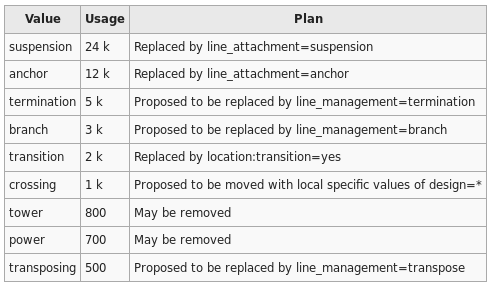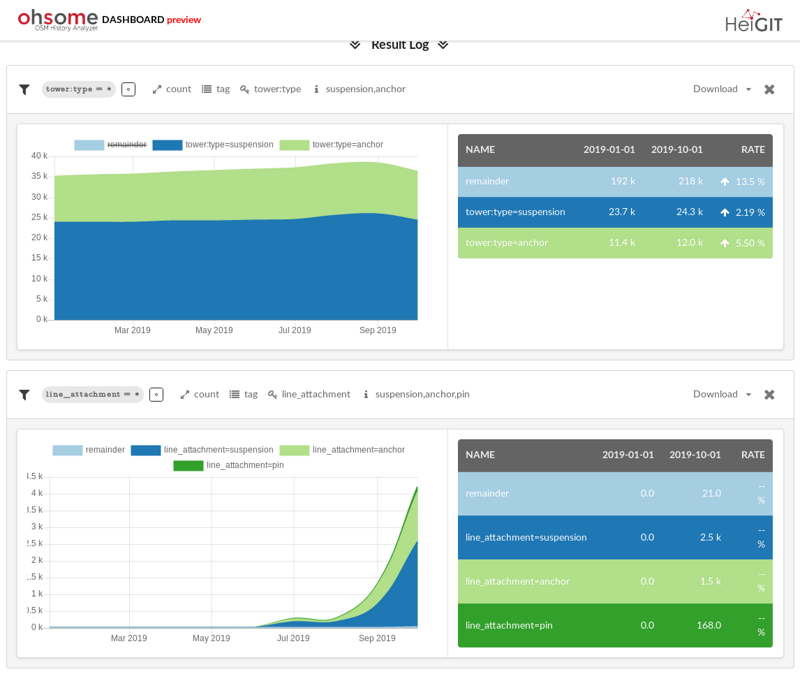Improving power tower/poles mapping without tower:type
Posted by InfosReseaux on 26 October 2019 in English. Last updated on 9 January 2020.Power lines mapping has been a common practice for years and their supports can be used as landmarks in the country. There is undergoing work to improve the way we describe lines supports, including towers, not only for power but for telecom or other utilities as well. This diary will help to understand how is it going.
Currently, power functions find corresponding values in tower:type key. Main tower:type key use case is certainly to define the shape or the purpose of a tall and thin building.
As :type suffix may not be desirable since it doesn’t bring any extra information, I’m currently contributing as to cleanup this key in the power lines context and encourage the use of more meaningful terminology to make the same information more accessible, known as line attachments and management.
These concepts aren’t restricted to power towers and would have been redefined on other kind of power supports if nothing hadn’t been done in past months to cover the need to give more and more consistent information about infrastructure.
Currently, tower:type is used with 1139 different values and 14 out of them get more than 1000 uses and yet 9 of them got properly described on wiki.
Here is a summary of usage and encouragement or proposal to clean up tower:type key.

Line attachment
osm.wiki/Proposed_features/Lines_attachments
Values suspension and anchor directly refers to the mean used to bound a power line to its support. Then it’s not really about the shape or purpose of the tower directly, as explained in the proposal reviewed earlier in 2019.
As line attachment starts to be an independent feature to map, a new key was proposed to absorb suspension and anchor plus add pin and pulley values as well. Review of the proposal show that tower:type at least misses pin and pulley values to be complete regarding line attachments. This conclusion is not intended to blame mappers or supporters but to show that the introduction of the new key allows to be more accurate on a precise question.
Adoption started right after the vote and line_attachment now reaches more than 5000 uses. Corresponding tower:type values were replaced accordingly with a downgrade of 2k uses.
You may compute such beautiful dashboards on this amazing tool at OHsome.org

Line management
osm.wiki/Proposed_features/Lines_management
Second main power line concept seen in tower:type is kind of line management, to indicate where lines branches, split, transpose or other possibilities. Initially, using those values prevent to indicate how lines are bound to towers with the same power:type key then, a second key ‘‘line_management’’ is required to reflect some remarkable configurations of lines around towers.
A second proposal is now in RFC to define which are the values to use and how they can be moved from tower:type and be available for other kind of supports. It should be said that more details can be put in OSM regarding each proposed value by defining corresponding keys in the future, not in this proposal, if required.
There are 4 values of tower:type key to replace and branch:type to abandon if this proposal get successfully reviewed. Votes will determine if this is an opportunity for the community.
Head ahead
As stated upside, some values remain to be addressed in a dedicated key to only let in tower:type values that refers to the actual tower shape or purpose. If you want to help, discussion regarding them can be opened at any time.
The current management proposal will certainly be refined prior to get voted, feel free to get involved in the review process to help with the concern you may have.
This is only a step to remove necessary :type suffixes from concepts that don’t require it and bring to OSM a more elaborated set of terms in tagging. Mapping utility supports like power towers or telecom pole is a worldwide challenge. For instance in France, professionals including operators and contractors rolling out overhead telecom cables are currently looking for approx. 16 millions missing shared power poles that weren’t mapped in operational GIS. There’s no doubt updating OSM can help.
François Lacombe / @InfosReseaux

Discussion
Comment from Oponka on 30 October 2019 at 15:58
Power line maps? Interesting, I hear first time.
Comment from InfosReseaux on 30 October 2019 at 16:03
Hi Oponka
Here you go : https://openinframap.org/#2/26/12 It’s a special render of live OSM data